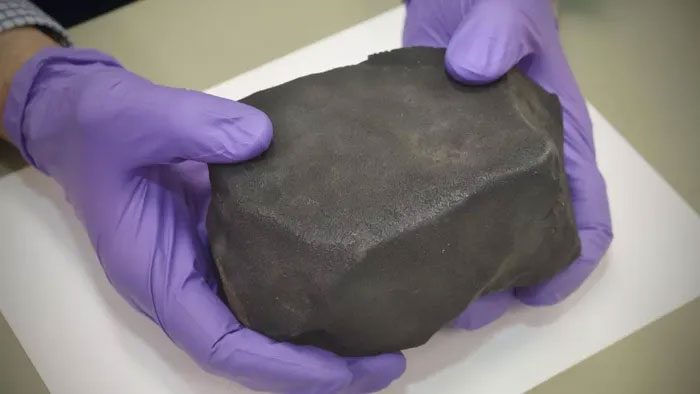In 2019, when NASA’s OSIRIS-REx spacecraft approached the asteroid Bennu, scientists observed something beautiful in the images sent back to Earth. Its surface featured marble-sized rocks peeking through.
Now, a new study on a meteorite that fell to Earth reveals how this asteroid behaves. Small collisions can eject rocks from the asteroid, but they fall back, pulled in by the meteorite’s gravitational force. Another collision can then smash the rocks back together, creating a type of mineral cement from across the asteroid’s surface.
Xin Yang, a researcher at the Field Museum in Chicago and the University of Chicago, and the first author of this new study, stated: “It provides a new explanation for how minerals on the surfaces of asteroids are mixed.”

The Aguas Zarcas meteorite broke apart in Costa Rica in 2019.
The Mystery of Meteorites
Previously, astronomers believed that asteroids had to undergo high-speed, high-pressure collisions to reshape their surfaces. Philipp Heck, the head of measurement at the Field Museum and the lead author of the study, noted in a statement.
However, the new research published on August 11 in the journal Nature Astronomy indicates that it doesn’t actually take much time to reshape an asteroid. Researchers discovered this while examining the Aguas Zarcas meteorite, which fell in Costa Rica in 2019. The fragments of this space rock, with a glassy sheen due to the temperatures experienced in the atmosphere, struck the roof of a house and a nearby dog kennel, according to the Buseck Meteorite Research Center at Arizona State University.
Instead of forcing the fragments apart, the researchers delved deeper into why they exhibited such resilience. Using computed tomography (CT) scanning techniques, scientists were able to examine the particles within the solid fragments. In most space rocks, these chondrule stones are spherical, but in the fragments of Aguas Zarcas, they were crushed and all oriented in the same direction. This is a clear indication that the fragments could not have been caused by a collision.
The 2019 images of the surface of asteroid Bennu helped narrate the rest of the story about the meteorite. Both Bennu and Aguas Zarcas are carbon-rich rocks formed early in the solar system’s history. Therefore, the Aguas Zarcas fragment that impacted Earth may have originated from an asteroid very similar to Bennu.
By combining observations from space and the laboratory, researchers concluded that the parent asteroid of Aguas Zarcas first underwent a high-speed collision, deforming part of the rock.
This weakened rock gradually broke apart, possibly due to the intense temperature changes that an asteroid experiences while spinning, causing the rock to expand, contract, and eventually fracture.
The gravitational pull of the parent asteroid then gradually caused the pebbles to fall back to parts of the surface that had never been impacted. Ultimately, the asteroid underwent another collision, fusing the impact and non-impact fragments into a single rock. This could be the impact that eventually led to the fragments reaching Earth.
While meteorite collisions in space are quite rare, observations of asteroid Bennu have shown scientists that asteroids often eject pebbles, and this may be more significant than large collisions.

















































